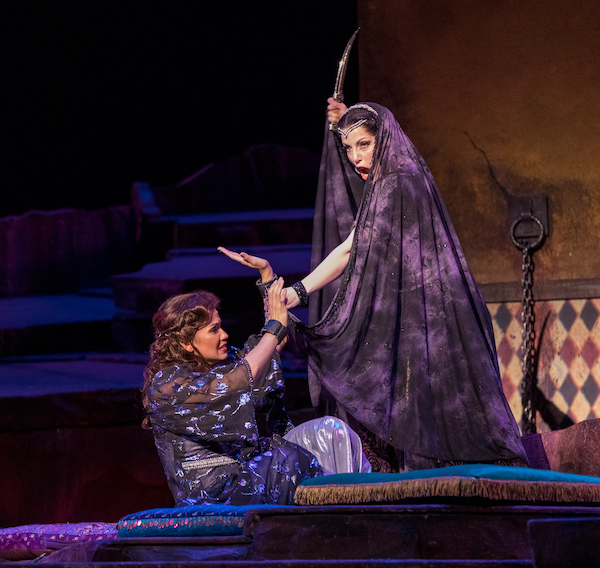Utah Opera’s superb cast, colorful staging make for an entertaining “Magic Flute”

Zulimar López-Hernández (left) as Pamina and Celena Shafer as the Queen of the Night in Mozart’s “The Magic Flute” at Utah Opera. Photo: Dana Sohm
Mozart’s beloved The Magic Flute opened Saturday night presented by Utah Opera at the Capitol Theater. The opera, Mozart’s last, was premiered mere months before the composer’s death at 35.
Utah Opera’s lively and whimsical production makes it easy to understand why the work has had such staying power over more than two centuries. With its invigorating mix of orchestral color, intimate arias, varied duets and trios, grand choruses, imaginative fantasy and a steady stream of playful humor, Saturday’s packed house was thoroughly entertained.
From the opening bars of the overture, it was clear that the orchestra was poised to have a very good night. Thierry Fischer is a world-class interpreter of Mozart’s scores, and he has forged an orchestra capable of meeting his demands. Even in the theater’s less-than-ideal acoustic, the orchestra sound was rich and inviting, with exquisitely shaped phrases and carefully crafted tone colors.
The quality of the orchestra playing provided a firm foundation for a superb cast of singers, each of whom seemed a natural fit for their roles. Led by Andrew Stenson as Tamino and Zulimar López-Hernández as Pamina the cast was consistently engaging–vocally polished and alive to the comedy as well as the dramatic moments.
Stenson established Tamino’s heroic presence from the start with his lyrical tenor in “Dies Bildnis,” sustaining this high level of performance throughout. López-Hernández’s was a captivating figure as Pamina, the heroine, with her performance a wonderful merging of music and stage presence. Her aria, “Ach, ich fühl’s” was beautifully sung and heartbreaking, radiating with sadness.
As the Queen of the Night, Celena Shafer executed the evening’s most technically challenging moments well. Joo Won Kang as Papageno won over the audience with his appealing humor. Matt Boehler as Sarastro inhabited his character with conviction, and sang with an warm yet authoritative deep voice.
Joseph Gaines as Monostatos played his character with the requisite mix of villainy and pitifulness. Grace Kahl was a convincing Papagena, making the quick switch vocally (and physically) from elderly to ingenue. The chorus, led by Michaella Calaretta contributed grandiose vigor in the closing moments of both acts.
The set, designed by Thaddeus Strassberger and lit by Glenn Linder, contained a great deal of textural depth and colorful luminosity, evoking Utah’s beautiful desert lands. The costumes, wigs and makeup were designed by Susan Memmott Allred and Kate Casalino, respectively, and were outstanding in their sophistication, elegance and attention to detail.
The Magic Flute runs through March 17 at the Capitol Theatre. utahopera.org; 801-355-2787.
Posted Mar 12, 2019 at 9:13 pm by Michael Kalm
The review while accurate, missed what almost every reviewer of the Magic Flute has missed, and that is the central importance of the three child spirits. The youngsters who played the roles here were absolutely stellar and their costuming was fantastic as well.